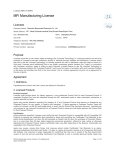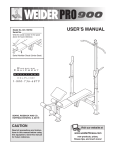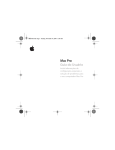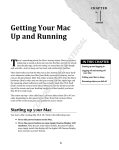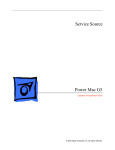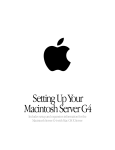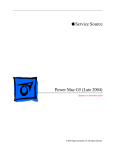Download ASUS MA356/A User's Manual
Transcript
Mac Pro User’s Guide Includes setup, expansion, and troubleshooting information for your Mac Pro computer Apple Computer, Inc. © 2006 Apple Computer, Inc. All rights reserved. Under the copyright laws, this manual may not be copied, in whole or in part, without the written consent of Apple. The Apple logo is a trademark of Apple Computer, Inc., registered in the U.S. and other countries. Use of the “keyboard” Apple logo (Option-Shift-K) for commercial purposes without the prior written consent of Apple may constitute trademark infringement and unfair competition in violation of federal and state laws. Every effort has been made to ensure that the information in this manual is accurate. Apple is not responsible for printing or clerical errors. Apple 1 Infinite Loop Cupertino, CA 95014-2084 408-996-1010 www.apple.com Apple, the Apple logo, AirPort, AppleShare, AppleTalk, FireWire, iCal, iLife, iPod, iTunes, Mac, Mac OS, and Macintosh are trademarks of Apple Computer, Inc., registered in the U.S. and other countries. Finder, the FireWire logo, Mac Pro, Safari, and SuperDrive are trademarks of Apple Computer, Inc. AppleCare and Apple Store are service marks of Apple Computer, Inc., registered in the U.S. and other countries. Mighty Mouse © Viacom International Inc. All rights reserved. The Mighty Mouse trademark is used under license. ENERGY STAR is a U.S. registered trademark. The Bluetooth word mark and logos are owned by the Bluetooth SIG, Inc. and any use of such marks by Apple Computer, Inc. is under license. This product includes software developed by the University of California, Berkeley, and its contributors. Intel and Intel Xeon are trademarks of Intel Corp. in the U. S. and other countries. Other company and product names mentioned herein are trademarks of their respective companies. Mention of third-party products is for informational purposes only and constitutes neither an endorsement nor a recommendation. Apple assumes no responsibility with regard to the performance or use of these products. Manufactured under license from Dolby Laboratories. “Dolby,” “Pro Logic,” and the double-D symbol are trademarks of Dolby Laboratories. Confidential Unpublished Works, © 1992–1997 Dolby Laboratories, Inc. All rights reserved. The product described in this manual incorporates copyright protection technology that is protected by method claims of certain U.S. patents and other intellectual property rights owned by Macrovision Corporation and other rights owners. Use of this copyright protection technology must be authorized by Macrovision Corporation and is intended for home and other limited viewing uses only unless otherwise authorized by Macrovision Corporation. Reverse engineering or disassembly is prohibited. Apparatus Claims of U.S. Patent Nos. 4,631,603, 4,577,216, 4,819,098 and 4,907,093 licensed for limited viewing uses only. Simultaneously published in the United States and Canada. Contents 5 Chapter 1: Getting Started 5 Setting Up Your Mac Pro 13 Putting Your Mac Pro to Sleep or Shutting It Down 15 16 18 20 22 24 Chapter 2: Getting to Know Your Mac Pro Basic Features on the Front of Your Mac Pro Ports and Connectors on the Back of Your Mac Pro More Ports and Connectors on the Back Internal Expansion Options Getting Answers 27 28 32 38 47 50 Chapter 3: Working Inside Your Computer Opening the Computer Installing Memory Installing Internal Storage Devices Adding PCI Express Cards Replacing the Internal Backup Battery 53 Chapter 4: Troubleshooting 53 Problems with Your Mac Pro 3 56 Problems with Software 57 Keeping Your Software Up to Date 57 Problems with AirPort Wireless Communication 58 Problems with Your Display 60 Problems with Your Internet Connection 63 Using Apple Hardware Test 64 65 66 68 Reinstalling the Software that Came with Your Computer Maximizing Ethernet Performance Learning More, Service, and Support Locating Your Serial Number 69 Appendix A: Specifications 77 77 78 80 82 Appendix B: Safety, Maintenance, and Ergonomics Important Safety Information General Maintenance Important Ergonomic and Health-Related Information Avoid Hearing Damage 83 Communications Regulation Information 87 Index 4 Contents 1 Getting Started 1 Congratulations on purchasing your new high-performance Mac Pro computer. This chapter contains instructions for setting up your computer and display. Your Mac Pro features the latest computer technology, including advanced 64-bit dual core processor technology, high-speed FB-DIMM memory, PCI Express graphics and expansion cards, and internal storage, all in an anodized aluminum chassis with easy access to internal components. Setting Up Your Mac Pro Your Mac Pro is designed so that you can set it up quickly and start using it right away. Follow the steps on the next few pages to set up your Mac Pro. Before you begin, remove any protective film from the outside of your computer and from the inside of the side panel. For information about opening the side panel, see “Opening the Computer” on page 28. 5 Step 1: Position your computer and display Pick up your Mac Pro by both of its handles using correct lifting techniques. If your display is heavy, use correct lifting techniques when positioning it as well. Position the computer and display so that:  They are each on a sturdy, flat surface  The power cable connectors don’t press against a wall or other object  The airflow in front of, behind, and below the display or computer is not obstructed  The computer’s optical drive trays have space to open in front The only way to shut off power completely to your computer and display is to disconnect their power plugs from the power source. Make sure the power cords for your computer and display are within easy reach so that you can unplug the computer or display when you need to. 6 Chapter 1 Getting Started Step 2: Plug in the power cord Plug the power cord completely into the recessed power cord socket on the back of your Mac Pro and plug the other end into a grounded outlet or a grounded power strip. Power cord socket Power cord plug Chapter 1 Getting Started 7 Step 3: Connect the display Connect your display as shown in the illustration below. Depending on the display, you may have one or more cables to connect. Check the instructions that came with the display for additional setup information. Display ports USB port FireWire 400 port Display cable You can connect two displays with Digital Visual Interface (DVI) connectors to the display ports on the back of your Mac Pro. You can connect any Apple display to either port. For full resolution on a 30-inch Apple Cinema HD Display, use DVI port 1. 8 Chapter 1 Getting Started DVI display port DVI display ports DVI to VGA Display Adapter VGA connector on display cable You can also connect displays that have an Apple Display Connector (ADC) or a video graphics array (VGA) connector using one of the following adapters:  To connect a VGA display, use the Apple DVI to VGA Display Adapter included with your Mac Pro to connect the display to the DVI port.  To connect an ADC display, use an Apple DVI to ADC Display Adapter, not included, to connect the display to the DVI port. To purchase an Apple DVI to ADC Display Adapter, contact an Apple Authorized Reseller, visit an Apple Store retail location, or go online to the Apple Store at www.apple.com/store. Chapter 1 Getting Started 9 Step 4: Connect an Ethernet cable To access the Internet or a network, connect one end of an Ethernet cable to either of the Ethernet ports on the back of your Mac Pro. Connect the other end to a DSL modem, cable modem, or Ethernet network. Gigabit Ethernet ports Step 5: Connect the keyboard and mouse Connect the keyboard cable to one of the USB (d) ports on the computer or on your display. Plug the Mighty Mouse cable into a USB port on the keyboard. 10 Chapter 1 Getting Started Plug the mouse into a USB port on the keyboard. Keyboard Mouse If the keyboard cable is not long enough to reach a USB port on your computer, use the keyboard extension cable that came with your computer. Apple keyboard extension cable Chapter 1 Getting Started 11 Using a Wireless Keyboard and Mouse If you purchased an Apple Wireless Keyboard and Mouse with your Mac Pro, follow the instructions that came with the keyboard and mouse to set them up. Step 6: Turn on your Mac Pro Press the power (®) button on the front of the computer to turn it on. If your display must be turned on separately, turn it on by pressing its power button. Step 7: Use Setup Assistant The first time you turn on your Mac Pro, Setup Assistant starts. Setup Assistant helps you enter your Internet and email information and set up a user account on your Mac Pro. If you already have a Mac, Setup Assistant can help you automatically transfer files, applications, and other information from your previous Mac to your new Mac Pro. Step 8: Customize Your Desktop and Set Your Preferences You can quickly make your desktop look the way you want using System Preferences. Choose Apple () > System Preferences from the menu bar. As you get to know your computer, explore System Preferences, your command center for most settings on your Mac Pro. For more information, open Mac Help and search for “System Preferences” or for the specific preference you want to change. Need Help Setting Up? If you don’t see anything on your screen or you think your computer did not start up properly, check the following:  Is the computer plugged into a power source? If it’s plugged into a power strip, is the power strip turned on?  Is the power cord securely plugged into the back of the computer? 12 Chapter 1 Getting Started  Are the keyboard and display cables connected correctly?  Is the display turned on? Are the brightness and contrast of the display adjusted correctly? If your display has brightness and contrast controls, adjust them.  If you still don’t see anything on your screen, restart your computer. Press and hold the computer’s power button for 5 or 6 seconds, until the computer turns off. Press it again to turn on the computer.  If you see a blinking question mark on the screen or a series of flashes from the status light, see Chapter 4, “Troubleshooting,” on page 53. Putting Your Mac Pro to Sleep or Shutting It Down When you finish working, you can put your Mac Pro to sleep or shut it down. Putting Your Mac Pro to Sleep If you will be away from your Mac Pro for only a short time, put the computer to sleep. When the computer is in sleep, the display’s screen is dark. You can quickly wake the computer from sleep and bypass the startup process. To put the computer to sleep, do one of the following:  Choose Apple () > Sleep.  Press the power button on the front of your Mac Pro.  Choose Apple () > System Preferences, click Energy Saver, and set a sleep timer. Chapter 1 Getting Started 13 To wake your computer from sleep, do one of the following:  Press any key on the keyboard.  Click the mouse.  Press the power button on the front of your Mac Pro. Shutting Down Your Mac Pro If you will not be using your Mac Pro for a day or more, you should turn it off. To turn off your Mac Pro, choose Apple () > Shut Down. Warning: Do not turn off your Mac Pro by turning off the switch on a power strip or by pulling out the computer’s power plug (unless you can’t turn off the computer any other way). Your files or system software could be damaged if your computer is not shut down properly. Warning: Shut down your Mac Pro before moving it. Moving your computer while the hard disk is spinning can damage the hard disk, causing loss of data or the inability to start up from the hard disk. 14 Chapter 1 Getting Started 2 Getting to Know Your Mac Pro 2 This chapter gives basic information you need to know about your Mac Pro. Read on for an overview of the features and ports of your computer. Getting the Latest Information The Apple website at www.apple.com links you to the latest Apple news, free downloads, and online catalogs of software and hardware for your Mac Pro. You can also find the manuals for many Apple products, and technical support for all of Apple’s products, on the Apple Support website at www.apple.com/support. 15 Basic Features on the Front of Your Mac Pro Optical drive 16 Status light Second optical drive (optional) f Headphone jack ® Power button USB 2.0 ports (2) FireWire 800 port FireWire 400 port Chapter 2 Getting to Know Your Mac Pro Optical drive Your Mac Pro has a DVD+R DL/DVD±RW/CD-RW SuperDrive, which can read CD-ROM, photo CD, audio, and DVD discs. It can write music, documents, and other files to CD-R, CD-RW, DVD±R, DVD±RW, and DVD+R Double Layer (DL) discs. To open the drive, press the Media Eject (C) key on your Apple Keyboard. If your Mac Pro has a second optical drive, press the Option and Media Eject (C) keys to open it. ® Power button Press this button to turn on your Mac Pro, put it to sleep, or wake it from sleep. To restart, press and hold this button for 5 or 6 seconds until your Mac Pro turns off, and, then press it again to turn it on. H FireWire 400 and 800 ports Connect your Mac Pro to FireWire digital video (DV) cameras, scanners, and external hard disk drives. Connect and disconnect FireWire devices without restarting. The FireWire 400 port supports data rates up to 400 megabits per second (Mbps).The FireWire 800 port supports data rates up to 800 Mbps. d USB 2.0 ports Connect your Mac Pro to USB keyboards, mice, printers, scanners, iPods, speakers, microphones, and hubs. Your display may also have USB ports. f Headphone jack Connect headphones to your Mac Pro through the headphone jack. When a headphone plug is inserted into the headphone jack, the built-in speaker is muted. Status light A white light indicates your Mac Pro is on; a pulsing light indicates it’s in sleep. Chapter 2 Getting to Know Your Mac Pro 17 Ports and Connectors on the Back of Your Mac Pro Power socket ¥ Locking latch d USB 2.0 ports (3) H FireWire 400 port H FireWire 800 port G Gigabit Ethernet ports (2) 18 Chapter 2 Getting to Know Your Mac Pro ≤ Power socket Connect the power cord that came with your Mac Pro. Do not use ordinary power or extension cords. ¥ Locking latch Lift the latch to open the side panel and access the internal components in your Mac Pro. If you are working inside your computer and the latch is down, the optical and hard drives are locked in place. You can attach a security lock to the latch to prevent access and secure the internal components. You can also attach a security cable to the latch or through the handles and feet to protect your Mac Pro. See page 37. d USB 2.0 ports Connect your Mac Pro to USB devices, such as keyboards, mice, printers, scanners, speakers, USB microphones, and USB hubs. Your display may also have USB ports. H FireWire 400 and 800 ports The FireWire 400 port supports data rates of 100, 200, and 400 Mbps. The FireWire 800 port supports data rates of 100, 200, 400, and 800 Mbps. G Dual Gigabit Ethernet ports with jumbo frame support Connect your Mac Pro to a high-speed Ethernet network to access the Internet or network resources such as printers and servers, and share information over the network using a CAT 5e cable. Chapter 2 Getting to Know Your Mac Pro 19 More Ports and Connectors on the Back PCI Express expansion slots £ DVI display port 1 £ DVI display port 2 Optical digital audio out port Optical digital audio in port , Audio line-in port - Audio line-out port 20 Chapter 2 Getting to Know Your Mac Pro PCI Express expansion slots (3) Expand your Mac Pro by installing up to three Peripheral Component Interconnect (PCI) Express cards in the covered slots labeled 2, 3, and 4. £ DVI display ports Connect displays that use a Digital Visual Interface (DVI) connector to the DVI display ports. Connect an Apple display, such as the 20-, 23-, or 30-inch Apple Cinema Display, to either port. For full resolution, connect the 30-inch Apple Cinema HD Display to port 1. You can also connect displays that use a video graphics array (VGA) connector with the Apple DVI to VGA Display Adapter that came with your Mac Pro. Optical digital audio in and out ports Connect to decks, receivers, digital instruments, and 5.1 surround-sound speaker systems using standard Toslink cables or fiber-optic cables with a 3.5 mm plastic or nylon optical plug. You can transfer stereo or encoded 5.1 audio using the S/PDIF (Sony/Philips Digital Interface) protocol and Toslink cables. , Analog audio line-in port Connect self-powered microphones, MP3 and CD players, and other devices with analog capability. - Analog audio line-out port Connect self-powered analog speakers and other devices with analog output capability. Chapter 2 Getting to Know Your Mac Pro 21 Internal Expansion Options Optical drive carrier Hard disk drive carriers (4) Slots 2–4: PCI Express Battery Slot 1: Double-wide PCI Express graphics (graphics card installed) Top memory card Bottom memory card 22 Chapter 2 Getting to Know Your Mac Pro Optical drives Your Mac Pro comes with one or two DVD+R DL/DVD±RW/CD-RW SuperDrives in the optical drive carrier. To replace an optical drive, see “Replacing the Optical Drive” on page 42. Hard disk drive Your Mac Pro comes with up to four hard disk drives installed in the drive carriers. To install or replace the hard disk drives, see “Installing Internal Storage Devices” on page 38. PCI Express slots Your Mac Pro has three PCI Express expansion slots. To install PCI cards in slots 2 through 4 to expand your computer’s capabilities, see “Adding PCI Express Cards” on page 47. Battery Your Mac Pro uses an internal backup battery. If your Mac Pro has trouble starting up, or if the system date and time are frequently incorrect, you may need to replace the battery. See “Replacing the Internal Backup Battery” on page 50. Double-wide PCI Express graphics slot Connect up to two displays to the graphics card in the PCI Express graphics slot (slot 1). You can replace the card in this slot and install additional graphics cards in PCI slots 2 through 4. See “Adding PCI Express Cards” on page 47. Memory cards Your Mac Pro has two memory cards. Each card holds up to 4 FB-DIMMS, for a total of 8 DIMMs. To add more memory, install 667MHz FB-DIMMs in pairs on the memory cards. See “Installing Memory” on page 32 for information about the specific type of memory used in Mac Pro. Chapter 2 Getting to Know Your Mac Pro 23 Getting Answers Much more information about using your Mac is available in Mac Help and on the Internet at www.apple.com/support. To open Mac Help: 1 Click the Finder icon in the Dock (the bar of icons along the edge of the screen). 2 Choose Help > Mac Help (click the Help menu in the menu bar and choose Mac Help). 3 Click in the search field, type a question, and press Return on your keyboard. More Information For more information about using your Mac Pro, see the following: 24 To learn about... See... Installing additional drives, memory, expansion cards, or changing the battery Chapter 3, “Working Inside Your Computer,” on page 27. Troubleshooting your computer if you have a problem Chapter 4, “Troubleshooting,” on page 53. Finding service and support for your Mac Pro “Learning More, Service, and Support” on page 66 or the Apple Support website www.apple.com/support. Using Mac OS X The Mac OS X website at www.apple.com/macosx/overview. Or open Mac Help and search for “Mac OS X.” Using iLife applications The iLife website at www.apple.com/ilife. Or open an iLife application, and then open Mac Help and type a question in the search field. Chapter 2 Getting to Know Your Mac Pro To learn about... See... Changing System Preferences Open System Preferences by choosing Apple () > System Preferences. Or open Mac Help and search for “system preferences.” Using your mouse or keyboard Open Mac Help and search for “mouse” or “keyboard.” Using AirPort wireless technology The AirPort Support page at www.apple.com/support/airport. Or open AirPort Help by clicking and holding the Home button at the top of a Mac Help page, and then select AirPort Help from the list Using Bluetooth® wireless technology The Bluetooth Support page at www.apple.com/support/ bluetooth. Or open the Bluetooth File Exchange application, located in the Utilities folder within the Applications folder, and choose Help > Bluetooth Help. Connecting a printer Open Mac Help and search for “printing.” FireWire and USB connections Open Mac Help and search for “USB” or “FireWire.” Connecting to the Internet Open Mac Help and search for “Internet.” Chapter 2 Getting to Know Your Mac Pro 25 3 Working Inside Your Computer 3 Use the information in this chapter to customize and expand your Mac Pro to fit your needs. This chapter provides information and instructions for working inside your computer. It includes information about important procedures in the following sections:  “Opening the Computer” on page 28  “Installing Memory” on page 32  “Installing Internal Storage Devices” on page 38  “Adding PCI Express Cards” on page 47  “Replacing the Internal Backup Battery” on page 50 Warning: Apple recommends that you have an Apple-certified technician install memory, PCIe cards, and internal storage devices. To contact an Apple Authorized Service Provider or Apple for service, see “Learning More, Service, and Support” on page 66. If you install these items yourself, you risk damaging your equipment, and such damage is not covered by the limited warranty on your computer. See an Apple Authorized Reseller or Apple Authorized Service Provider for additional information about this or any other warranty question. 27 Opening the Computer 1 Before you open your Mac Pro, shut it down by choosing Apple () > Shut Down. · Warning: Always shut down your Mac Pro before opening it to avoid damaging its internal components or the components you want to install. Do not open the computer or attempt to install items inside it while it is on. 2 Wait 5 to 10 minutes to allow the computer’s internal components to cool. · Warning: After shutting down your computer, the internal components can be very hot. Let the computer cool down before continuing. 3 Touch the metal on the outside of your Mac Pro to discharge any static electricity from your body. Important: Always discharge static before you touch any parts or install any components inside the computer. To avoid generating static, do not walk around the room until you finish installing the cards, memory, or internal storage device and close the computer. 28 Chapter 3 Working Inside Your Computer Touch the metal on top of the computer. 4 Unplug all the cables and the power cord from the computer. · Warning: To avoid damaging internal components or components you want to install, always unplug your Mac Pro. Don’t attempt to install items while it’s plugged in. Chapter 3 Working Inside Your Computer 29 5 Hold the side panel and lift the latch on the back of the computer. Lift the latch while holding the side panel. 30 Chapter 3 Working Inside Your Computer 6 Remove the side panel. Pull the top of the side panel out and lift it up. Important: When you remove the side panel, hold it securely. Chapter 3 Working Inside Your Computer 31 Installing Memory Your Mac Pro has two memory cards with 4 memory slots on each card (in four banks of two each). Your Mac Pro comes with a minimum of 1 GB of memory, installed as a pair of 512 MB fully buffered dual inline memory modules (FB-DIMMs) in two of the DIMM slots. You can install additional pairs of 512 MB, 1 GB, or 2 GB FB-DIMMS in the open DIMM slots on the memory cards. DIMMs must be installed in equal-sized pairs and fit these specifications:  667 MHz, FB-DIMMS  72-bit wide, 240-pin modules  36 devices maximum per DIMM  Error-correcting code (ECC) Important: Apple recommends that you use Apple-approved FB-DIMMS. Non Appleapproved FB-DIMMS may cause your Mac Pro to operate louder or decrease performance to conserve heat. DIMMs from older Mac computers cannot be used in your Mac Pro. Note: When purchasing DIMMs for use in Mac computers, make sure that the memory vendor conforms to the Joint Electron Device Engineering Council (JEDEC) specification. Check with your memory vendor to ensure that the DIMMs support the correct timing modes and that the Serial Presence Detect (SPD) feature has been programmed properly, as described in the JEDEC specification. To check the compatibility of your DIMMs, see the Macintosh Products Guide on Apple’s website at www.apple.com/guide. You can purchase Apple-branded memory online from the Apple Store at www.apple.com/store. 32 Chapter 3 Working Inside Your Computer To install memory: 1 Open your computer and remove the side panel, following the instructions on page 28. · Warning: Always wait 5 to 10 minutes for your Mac Pro to cool down before you attempt to install memory. The components on the memory cards may be very hot. 2 Remove the memory card and place it on a soft clean cloth. Chapter 3 Working Inside Your Computer 33 3 Open the ejectors on the DIMM slot by pushing them out to the sides. 4 Align the first FB-DIMM in the slot on the memory card and push both ends of the FBDIMM down until the tabs are vertical and the ejectors snap into place. Repeat to install the second FB-DIMM. Don’t touch the gold DIMM connectors. Important: Add DIMMs to the memory cards in the order shown here. Top memory card First pair of additional DIMMs Second pair of additional DIMMs Third pair of additional DIMMs 34 Chapter 3 Working Inside Your Computer Bottom memory card With the computer on its side, push the memory cards straight down into the memory slots. 5 Lay your Mac Pro down on a soft, clean cloth on the desk or work surface to avoid scratching the work surface or your Mac Pro. 6 Install the memory cards, pushing slightly until they are seated in the memory slot. Chapter 3 Working Inside Your Computer 35 7 Stand your Mac Pro up and replace the side panel. Important: When you replace the side panel, hold it securely so it stays in place as you push the latch down. Place the side panel in the slot and then push to close. 36 Chapter 3 Working Inside Your Computer 8 Push the latch down to secure the side panel. While pushing the side panel against the computer, push the latch down until it is firmly secured against the back of the computer. Chapter 3 Working Inside Your Computer To lock the side panel or secure the computer, flip down the lock tab before you close the latch. This provides a metal loop through which you can attach a lock or cable. 37 Installing Internal Storage Devices Your Mac Pro has room for six internal drives: two optical drives and four hard disk drives. In most configurations, a single hard disk drive occupies the first hard drive bay and an optical drive is located in the top optical drive bay. You can add up to three additional Serial ATA (SATA) 3 Gbps hard disk drives to the empty hard drive bays. The drives must meet these specifications:  Type: SATA 3 Gbps  Width: 3.9 inches (102 mm)  Depth: 5.7 inches (147 mm)  Height: 1.0 inch For more information about requirements and devices supported, visit an Apple Authorized Reseller or the Apple Support website at www.apple.com/support. Important: Use the original Apple cables that came with your Mac Pro when you install or replace the optical drives. Installing SATA 3 Gbps Hard Disk Drives Your Mac Pro can accommodate up to four internal 1-inch-high SATA 3 Gbps hard disk drives in the hard drive bays. If your Mac Pro comes with a single drive installed, it’s in the first bay. You can install drives in the second, third, and fourth hard drive bays. 38 Chapter 3 Working Inside Your Computer To install a hard disk drive: 1 Open your Mac Pro and remove the side panel following the instructions that begin on page 28. 2 Lift the latch to unlock the hard drive carriers. Important: When the latch is down, the carriers are locked in the drive bays and can’t be removed. 3 Pull the hard drive carrier out of the drive bay. Pull out the hard drive carrier. Lift the latch to unlock the carriers. Chapter 3 Working Inside Your Computer 39 4 Use the four screws on the carrier to attach the hard disk drive to the carrier. Important: If the printed circuit board is exposed on the bottom of the hard disk drive, hold the drive by its sides. To avoid damaging the drive, don’t touch the printed circuit board. Position the connectors towards the rear. 40 Chapter 3 Working Inside Your Computer 5 Lift the latch and then slide the carrier over the guides and into the drive bay, until it’s seated in the bay and snaps into place. The connectors on the drive plug into the computer when fully seated. Make sure the latch is up. 6 Replace the side panel and push the latch down to secure it. Chapter 3 Working Inside Your Computer 41 Replacing the Optical Drive Your Mac Pro comes with one or two SuperDrives installed in the optical drive bays. Follow these instructions to replace your optical drive. Important: Contact your drive manufacturer or consult the manufacturer’s website to determine if your drive is set to cable select mode. Before installation, set the drive to cable select mode if the manufacturer hasn’t already done so. To replace the optical drive: 1 Open your Mac Pro and remove the side panel following the instructions on page 28. 2 Lift the latch to unlock the optical drive carriers. Important: When the latch is down, the drives and carriers are locked in the drive bays and can’t be removed. 3 Pull the optical drive carrier halfway out of the optical drive bay. Slide the carrier partially out of the computer. Make sure the latch is up. 42 Chapter 3 Working Inside Your Computer 4 Disconnect the power and ribbon cables from the optical drive and remove the carrier. Chapter 3 Working Inside Your Computer 43 5 Remove the optical drive from the carrier by unscrewing the four attachment screws. 6 Use the four screws from the original optical drive to attach the replacement drive to the carrier. Four extra screws 44 Chapter 3 Working Inside Your Computer 7 Slide the optical drive and carrier over the guides halfway into the drive bay, 8 Attach the power and ribbon cables to the back of the drive. Important: If you’re replacing two optical drives, attach the connector on the end of the ribbon cable to the top drive and the connector in the middle to the bottom drive. Middle connectors Chapter 3 Working Inside Your Computer 45 9 Lift the latch and then slide the optical drive carrier into the drive bay, pushing it into place. Make sure the latch is up. 10 Replace the side panel and push the latch down to secure it. 46 Chapter 3 Working Inside Your Computer Adding PCI Express Cards You can expand the capabilities of your Mac Pro by installing cards in the Peripheral Component Interconnect (PCI) Express slots. Your Mac Pro has one double-wide PCI Express graphics slot and three PCI Express expansion slots, for a total of four slots. These slots accommodate PCI Express graphics cards and expansion cards. About PCI Express Cards Your Mac Pro comes with a high-performance PCI Express graphics card, which contains the graphics processor unit (GPU) and provides the computer’s display ports. The graphics card is installed in slot1. You can install additional PCI Express graphics and expansion cards. Before installing a card, check its specifications to make sure it can operate in your Mac Pro. To adjust the bandwidth of the PCI Express slots in your Mac Pro, use the Expansion Slot Utility, located in the Utilities folder within the Applications folder. Important: Combined maximum power consumption for all four PCI Express slots must not exceed 300 watts (W). To install a PCI Express card: 1 Open the computer and remove the side panel (see page 28). · Warning: To avoid damaging internal components or the components you want to install, always turn off and then unplug your Mac Pro. Wait 5 to 10 minutes for it to cool down. Do not attempt to install items while it is plugged in. 2 Lay your Mac Pro down on a soft, clean cloth to avoid scratching it or the work surface. Chapter 3 Working Inside Your Computer 47 3 Unscrew the captive screw in the PCI bracket and remove the bracket. 4 Remove the port access cover from the slot in which you plan to install the card. PCI bracket Port access cover To remove a card, push on the tab to release the catch. 5 Remove your new card from its static-proof bag and hold it by its corners. Don’t touch the gold connector or the components on the card. 48 Chapter 3 Working Inside Your Computer 6 Align the card’s connector with the expansion slot and press the card into the slot. Did You Know?—Installing a Full-Length PCI Card It may be easier to install a PCI card if you remove the hard disk drives and carriers, and remove adjacent cards. If you have a full-length card, install the end of the card in the card guide first, and then align the card with the PCI slot to finish installing it. Secure the card with the PCI bracket. Insert the PCI bracket under the brace. Port access opening PCI Express slot If the PCI Express card you are installing is full-length (12 inches), make sure it fits in the appropriate card guide. Chapter 3 Working Inside Your Computer 49 7 Press the card gently but firmly until the connector is fully inserted. Press only on the bare areas of the card to avoid damaging the components. Note: Don’t rock the card from side to side or force it. If you meet resistance, check the connector and slot for damage or obstructions, then try inserting the card again. 8 Pull the card gently to see if it is properly connected. If it stays in place and its gold connectors are barely visible, the card is connected. 9 Replace the PCI bracket and tighten the screw to secure the card. Warning: If you remove a card and don’t install a replacement, place a port access cover over the empty slot to keep foreign objects out of the enclosure. An uncovered slot affects the airflow that cools the internal components and may cause damage. 10 Replace the side panel and push the latch down to secure it. Replacing the Internal Backup Battery Your Mac Pro uses a CR 2032 Lithium battery that preserves settings, such as the date and time, when your Mac Pro is off. If you notice intermittent problems when your Mac Pro starts up or changes in the date and time settings, you may need to replace the battery. Important: Dispose of the old battery according to your local environmental laws. To replace the battery: 1 Open your Mac Pro and remove the side panel, following the instructions on page 28. 2 Remove any PCI Express cards that block access to the battery. See “Adding PCI Express Cards” on page 47 for instructions. 50 Chapter 3 Working Inside Your Computer 3 Remove the old battery from the holder. · Warning: Installing the battery incorrectly may cause an explosion. Use only the same type of battery or an equivalent recommended by the manufacturer of the original. 4 Insert the new battery in the holder with the positive (+) side facing up. Slide the old battery out. Insert the new battery positive (+) side up. Remove the card in slot 1. Push on the tab to release the catch. 5 Replace the PCI Express cards that you removed. See page 47. 6 Replace the side panel and push the latch down to secure it. Chapter 3 Working Inside Your Computer 51 4 Troubleshooting 4 If you have a problem while working with your Mac Pro, here are some things you can try right away. Occasionally you may have a problem while working with your Mac Pro. This chapter gives you some solutions to try. Problems with Your Mac Pro If your Mac Pro won’t respond or turn on, you have trouble ejecting a disk, or the status light is flashing, try the steps in this section. The computer won’t respond or the pointer won’t move. First, make sure the mouse and keyboard are connected by unplugging and then plugging in the connectors, and make sure they are firmly seated. Then try to cancel what the computer is doing.  Press the Command (x) and Q keys at the same time to try to quit the current application.  Press the Command (x) and period keys at the same time. If a dialog appears, click Cancel. 53  Choose Apple () > Force Quit and select the application you want to quit. You can also force quit by pressing the Esc, Option, and Command (x) keys at the same time. Restart your Mac Pro by choosing Apple () > Restart to be sure the problem is entirely cleared up. You can also restart by pressing the power (®) button for about 5 or 6 seconds until your Mac Pro shuts down. Press the power (®) button again to start up your Mac Pro.  If the problem occurs only when you use a particular program, check with the program’s manufacturer to see if it is compatible with your computer.  If the problem occurs frequently, choose Help > Mac Help and search for “problems. “ The computer won’t turn on or start up.  Make sure the power cord is connected to a working power source. The plug on the power cord must be completely inserted into the computer’s power socket and firmly seated.  If your computer still does not start up, try resetting the parameter random access memory (PRAM). Turn on the computer and immediately hold down the Command (x), Option, P, and R keys until you hear the startup sound a second time. Release the keys. Set your hard disk as the computer’s startup disk, by doing the following: 1 Choose Apple () > System Preferences. 2 Click Startup Disk. 3 Select your hard disk. The PRAM is reset to the default values and your clock settings may need to be reset.  If your computer does not start up after resetting the PRAM, restart your computer while holding down the Option key to select your startup disk. 54 Chapter 4 Troubleshooting  If this doesn't work, restart your computer while holding down the Shift key. You are unable to eject a disc. A file on the disc may be in use. Quit applications that are open, and then try again. If that doesn’t work, choose Apple () > Restart and hold down either the mouse button or the Media Eject (C) key on your Apple Keyboard. If that doesn’t work: 1 Shut down the computer. 2 Gently press down the front panel covering the front of the drive tray. 3 Carefully insert the end of a straightened paper clip into the small hole beneath the drive tray. 4 Push firmly until the tray opens. 5 Pull out the tray, remove the disc, and push the tray to close it. The status light flashes and the computer won’t start up.  If you recently installed memory, a PCI expansion card, or another internal component, make sure that it is correctly installed and that it is compatible with your computer. See if removing it allows the computer to start up.  If the status light still flashes, determine the number of flashes to identify the problem:  One short flash followed by a longer off period: No valid memory.  Three short flashes followed by a longer off period: Failed memory. Chapter 4 Troubleshooting 55 Problems with Software When an application “freezes” or does not respond, Mac OS X provides a way to quit the application without restarting your computer. Quitting a frozen application may allow you to save your work in other open applications. To force an application to quit: 1 Press Command (x)-Option-Esc or choose Apple () > Force Quit from the menu bar. 2 Select the name of the application you want to quit in the Force Quit Applications dialogue. 3 Click Force Quit. The application quits, leaving all other applications open. You have a problem with a software program.  Use Software Update to ensure that you have the latest drivers, bug fixes, and other updates.  For problems with software from a manufacturer other than Apple, contact the manufacturer. You have a problem using your computer or working with Mac OS X.  Look in Mac Help (in the Help menu) for instructions and troubleshooting information.  For the latest troubleshooting information and software updates, go to the Apple Support website at www.apple.com/support. 56 Chapter 4 Troubleshooting Keeping Your Software Up to Date You can connect to the Internet and automatically download and install the latest free software versions, drivers, and other enhancements from Apple. When you are connected to the Internet, Software Update checks Apple’s Internet servers to see if any updates are available for your computer. You can set your Mac to check the Apple servers periodically and download and install updated software. To check for updated software: 1 Open System Preferences. 2 Click the Software Update icon and follow the onscreen instructions.  For more information, search for “Software Update” in Mac Help.  For the latest information about Mac OS X, go to the Mac OS X website at www.apple.com/macosx. Problems with AirPort Wireless Communication If you have trouble using AirPort wireless communication:  Make sure you have properly configured the software according to the instructions that came with your base station.  Make sure the computer or network you are trying to connect to is running and has a wireless access point.  Make sure you are within antenna range of the other computer or the network’s access point. Nearby electronic devices or metal structures can interfere with wireless communication and reduce this range. Repositioning or rotating the computer may improve reception. Chapter 4 Troubleshooting 57  Check the AirPort signal level. You may have up to four bars in the AirPort status icon in the menu bar.  For more information, see the instructions that came with the wireless device or search for “AirPort” in Mac Help. Problems with Your Display Warning: If you have a problem with your Apple display and nothing in this manual solves it, contact an Apple Authorized Service Provider or Apple for assistance. If you attempt to repair the display yourself, any damage you may cause to the display will not be covered by the limited warranty on your display. Contact an Apple Authorized Reseller or Apple Authorized Service Provider for additional information about this or any other warranty question. No image appears on the screen.  Make sure the display and computer are turned on.  Make sure the cables are connected properly to your computer and the display.  If your graphics card has an internal power cable, make sure its connected to the card and the logic board.  Make sure your computer is not in sleep. Press the power button or any key to see if the computer wakes.  Make sure the display brightness and contrast are set properly. Some displays have brightness and contrast controls on or under their front edge. 58 Chapter 4 Troubleshooting  Reset the PRAM by restarting the computer while holding down the Command (x), Option, P, and R keys until you hear the startup sound a second time. Then start up using the software installation disc that came with your computer. The screen image appears dim or flickers.  Adjust the display brightness and contrast settings. Some displays have brightness and contrast controls on or under their front edge. Or you may be able to adjust brightness or contrast using the Displays pane of System Preferences.  Calibrate the display by choosing Apple () > System Preferences. Click Displays, select Color, and click Calibrate. For more information on color and your display, see Mac Help.  The flickering may be caused by interference from a nearby power line, a fluorescent light, or an electrical device—for example, a radio, a microwave oven, or another computer. Try relocating nearby electrical devices or moving your computer and display. No colors appear on the screen or the colors don’t look right.  Make sure the display is connected firmly to the computer.  Calibrate your display, as described above.  Open the Displays pane of System Preferences and make sure your display is set to display colors. For more information on color and your display, see Mac Help. After you change the screen resolution, desktop icons move. Changing the screen resolution affects the display of information on your screen. The operating system may reposition icons when you change the screen resolution. Chapter 4 Troubleshooting 59 The screen freezes.  Force the frozen application to quit. Choose Apple () > Force Quit and select the application.  If that doesn’t work, force the computer to restart by pressing the power button (®) for 5 or 6 seconds until your Mac Pro shuts down. Press the power button (®) again to start up your Mac Pro. The light on the front of the display is flashing. On some Apple flat panel displays, the power light displays a series of short flashes when an error is detected.  If you see a repeating sequence of three short flashes, the display is detecting input in the wrong video format. Make sure your display is compatible with your graphics card and that you’ve installed the correct display software, if your display came with installation software.  If you see a sequence of two short flashes and a long flash, the display is detecting a problem with a backlighting lamp. Contact an Apple Authorized Reseller or Apple Authorized Service Provider. Problems with Your Internet Connection If you have trouble with your Internet connection, you can try the steps in this section starting with Network Diagnostics. To use Network Diagnostics: 1 Choose Apple () > System Preferences. 2 Click Network and then click “Assist me.” 60 Chapter 4 Troubleshooting 3 Click Diagnostics to open Network Diagnostics. 4 Follow the onscreen instructions. If Network Diagnostics can’t resolve the problem, there may be a problem with the Internet service provider (ISP) you are trying to connect to, with an external device you are using to connect to your ISP, or with the server you are trying to access. You can also try the following steps. Cable Modem, DSL, and LAN Internet Connections Make sure all modem cables are fully plugged in, including the modem power cord, the cable from the modem to the computer, and the cable from the modem to the wall jack. Check the cables and power supplies for Ethernet hubs and routers. Turn the modem on and off to reset the modem hardware. Turn off your DSL or cable modem for a few minutes, and then turn it back on. Some ISPs recommend that you unplug the modem’s power cord. If your modem has a reset button, you can press it either before or after you turn the power off and on. PPPoE Connections If you are unable to connect to your Internet service provider using PPPoE, make sure you have entered the correct information in Network preferences. Check System Preferences settings: 1 Choose Apple () > System Preferences. 2 Click Network. 3 Choose Network Port Configurations from the Show pop-up menu. 4 Drag Built-in Ethernet to the top of the Port Configurations list. 5 Choose Built-in Ethernet from the Show pop-up menu. Chapter 4 Troubleshooting 61 6 Click PPPoE. 7 Select “Connect using PPPoE.” 8 Check the Account Name field to be sure you have entered the correct information from your ISP. 9 Retype your password if you chose to save your password, making sure it is correct. 10 Click TCP/IP. Make sure you’ve entered the correct information from your ISP in this pane. 11 Click Apply Now. Network Connections Make sure the Ethernet cable is plugged into your computer and into the network. Check the cables and power supplies to your Ethernet hubs and routers. If you have two or more computers sharing an Internet connection, be sure that your network is set up properly. You need to know if your ISP provides only one IP address or if it provides multiple IP addresses, one for each computer. If only one IP address is used, then you must have a router capable of sharing the connection, also known as network address translation (NAT) or “IP masquerading.” For setup information, check the documentation provided with your router or ask the person who set up your network. You can use an AirPort Base Station to share one IP address among multiple computers. For information about using an AirPort Base Station, check Mac Help or visit the Apple AirPort website at www.apple.com/support/ airport. If you cannot resolve the issue using these steps, contact your ISP or network administrator. 62 Chapter 4 Troubleshooting Using Apple Hardware Test You can use Apple Hardware Test to help determine if there is a problem with your computer’s hardware. To use Apple Hardware Test: 1 Disconnect all external devices from your computer except the keyboard and mouse. If you have an Ethernet cable connected, disconnect it. 2 Insert the Mac OS X Install Disc 1 that came with your computer. 3 Restart your computer and hold down the D key as it starts up. A list of available startup volumes appears. 4 Click Apple Hardware Test and click the right arrow. 5 Follow the onscreen instructions when the Apple Hardware Test main screen appears (after about 45 seconds). 6 If Apple Hardware Test detects a problem, it displays an error code. Make a note of the error code before pursuing support options. If Apple Hardware Test does not detect a hardware failure, the problem may be software-related. For more information about Apple Hardware Test, see the Apple Hardware Test Read Me file on the Mac OS X Install Disc 1. Chapter 4 Troubleshooting 63 Reinstalling the Software that Came with Your Computer Use the software installation discs that came with your computer to reinstall Mac OS X and the applications that came with your computer. Important: Apple recommends that you back up the data on your hard disk before restoring software. Apple is not responsible for any lost data. Installing Mac OS X To install Mac OS X: 1 Back up your important files, if possible. 2 Insert the Mac OS X Install Disc 1 that came with your computer. 3 Double-click “Install Mac OS X and Bundled Software.” 4 Follow the onscreen instructions. 5 Select the destination disk for installation and continue following the onscreen instructions. Your computer may restart and ask you to insert the next Mac OS X disc. Important: Because the “Erase and Install” option erases your destination disk, you should back up your essential files before installing Mac OS X and other applications. Installing Applications To install the applications that came with your computer, follow the steps below. Your computer must have Mac OS X already installed. To install the applications: 1 Back up your important files, if possible. 2 Insert the Mac OS X Install Disc 1 that came with your computer. 64 Chapter 4 Troubleshooting 3 Double-click “Bundled Software.” 4 Follow the onscreen instructions. 5 Select the destination disk for installation and continue following the onscreen instructions. Note: iCal, iChat, iSync, iTunes, and Safari are part of Mac OS X. To install these applications, follow the “Installing Mac OS X” instructions above. Maximizing Ethernet Performance Your computer performs best when the Ethernet port to which it is connected is set to autonegotiate. Ask your network administrator to verify this setting. Important: If you experience connection problems on your network, make sure your network switch is set to autonegotiate, if possible. If a switch’s port is not autonegotiating, your computer detects the appropriate speed but defaults to halfduplex mode. If the switch’s port at the other end of the link is configured for fullduplex mode, a large number of late events can occur on the link. If it isn’t possible to set the switch to autonegotiate, then set the switch’s port to half-duplex. For more information, see the documentation that came with the Ethernet switch. Note: If you connect your computer directly to a configurable Ethernet switch, have your network administrator disable the spanning tree protocol on that port. Otherwise your computer may duplicate the AppleTalk address of another computer on the same network and both network connections may become unreliable. Chapter 4 Troubleshooting 65 Learning More, Service, and Support If your Mac Pro needs service, take it to an Apple Authorized Service Provider or contact Apple for service. You can find more information about your Mac Pro through online resources, onscreen help, System Profiler, or Apple Hardware Test. If you didn’t order AirPort or Bluetooth wireless technology with your Mac Pro, contact an Apple Authorized Service Provider or an Apple Store. Online Resources For online service and support information, go to www.apple.com/support/. Choose your country from the pop-up menu. You can search the AppleCare Knowledge Base, check for software updates, or get help on Apple’s discussion boards. Onscreen Help You can often find answers to your questions, as well as instructions and troubleshooting information, in Mac Help. Choose Help > Mac Help. System Profiler To get information about your computer, use System Profiler. System Profiler shows you which hardware and software is installed, the serial number and operating system version, how much memory is installed, and more. To open System Profiler, choose Apple () > About This Mac from the menu bar and then click More Info. Apple Hardware Test You can use Apple Hardware Test to diagnose hardware problems on your Mac Pro. For more information, see “Using Apple Hardware Test” on page 63. 66 Chapter 4 Troubleshooting AppleCare Service and Support Information Your Mac Pro comes with 90 days of telephone support and one year of service coverage at an Apple-authorized repair center. You can extend your coverage by purchasing the AppleCare Protection Plan. For more information, visit the website address for your country listed below. If you need further assistance, AppleCare telephone support representatives can help you with installing and opening applications, and with basic troubleshooting. Call the support center number nearest you (the first 90 days are complimentary). Have the date of purchase and your Mac Pro serial number ready when you call. Note: Your 90 days of complimentary telephone support begins on the date of purchase. Telephone fees may apply. Country Phone United States 1-800-275-2273 Website www.apple.com/support Australia (61) 133-622 www.apple.com/au/support Canada (English) (French) 1-800-263-3394 www.apple.com/ca/support www.apple.com/ca/fr/support Ireland (353) 1850 946191 www.apple.com/ie/support New Zealand 00800-7666-7666 www.apple.com/au/support United Kingdom (44) 0870 876 0753 www.apple.com/uk/support For a complete list, go to www.apple.com/contact/phone_contacts.html. Telephone numbers are subject to change, and local and national telephone rates may apply. Chapter 4 Troubleshooting 67 Locating Your Serial Number System Profiler shows the serial number of your Mac Pro. Open System Profiler, located in the Utilities folder in the Applications folder, and click the System Profile tab. The serial number is also on the configuration label, which is located on the back of your Mac Pro near the video ports. 68 Chapter 4 Troubleshooting Specifications A Appendix A Processor and Memory Specifications Processor  Dual-Core Intel Xeon processor  4 megabytes (MB) of on-chip L2 cache per dual-core processor  1333 MHz dual independent frontside bus Random-access memory (RAM)  Fully buffered Dual Inline Memory Modules (FB-DIMMs)  PC2-5300, 667 MHz FB-DIMMs  DIMMs must be installed in pairs of equal size and equal specification (an equal number of devices per DIMM)  Eight DIMM slots available (four slots per memory card)  Error-correcting code (ECC)  72-bit wide, 240-pin modules  36 memory devices maximum per DIMM  Contain an Apple-approved heat sink (for best acoustic performance)  Conform to JEDEC specification (see page 32)  Maximum height of 1.25 inches  Nonparity 69 System Profiler, located in the Utilities folder in the Applications folder, provides information about your computer, including the amount of memory. Graphics Card PCI Express graphics card with two Digital Visual Interface (DVI) connectors. Video Display Modes For technical specifications for your display:  Apple displays: Go to www.apple.com/displays.  Non-Apple displays: Go to www.apple.com/guide. SuperDrive (DVD+R DL/DVD±RW/CD-RW) Specifications  Disc diameters supported: 12 cm and 8 cm Data formats  CD-ROM  CD-Audio  CD-R  CD-RW  CD-I  CD-I Bridge  CD Extended  CD Mixed Mode  Photo CD  Video CD 70 Appendix A Specifications  Enhanced CD  DVD-Video  DVD±R  DVD±RW  DVD+R DL USB Specifications  Support for Universal Serial Bus (USB) 2.0 and 1.1  Seven external USB Type A ports  Two USB 2.0 ports on the front  Three USB 2.0 ports on the back  Two USB 1.1 ports on the Apple Keyboard  Each rear port is on a separate 480 megabit-per-second (Mbps) USB channel  500 milliamperes (mA) available for a total of 1.5 A on the rear and 1.0 A on the front FireWire Specifications  Support for FireWire 400 and FireWire 800  Four external FireWire ports: one FireWire 400 port and one FireWire 800 port on both the front and back  Data transfer speed:  FireWire 400: 100, 200, and 400 Mbps  FireWire 800: 100, 200, 400, and 800 Mbps Appendix A Specifications 71 Power  Output voltage: Approximately 12 V  Output power: Up to a maximum of 28 W for all 4 ports or 7 W for any one port Ethernet Specifications  IEEE 802.3 compliant  Maximum cable length: 100 meters (m)  Protocols: Open Transport, AppleShare, AppleTalk, NetWare for Macintosh, TCP/IP  Connector: RJ-45 for 10Base-T, 100Base-TX, and 1000Base-T  Media, 10Base-T: Category (CAT) 3 or higher UTP on 2 pairs up to 100 m  Media, 100Base-TX: CAT 5e UTP on 2 pairs up to 100 m  Media, 1000Base-T: CAT 5e UTP on 4 pairs up to 100 m  Channel speeds: IEEE Autonegotiation of 10Base-T, 100Base-TX, and 1000Base-T Bluetooth 2.0+EDR Specifications (Optional)  Wireless data rate: Up to 3 Mbps  Range: Up to 10 meters or 33 feet (data rates may vary depending on environmental conditions)  Frequency band: 2.4 gigahertz (GHz) AirPort Extreme Specifications (Optional)  Wireless data rate: Up to 54 Mbps  Range: Up to 150 feet (data rates may vary depending on environmental conditions)  Frequency band: 2.4 gigahertz (GHz)  Radio output power: 15 dBm (nominal) 72 Appendix A Specifications Compatibility  802.11 b and g Optical Digital Audio Specifications  Data format: Sony/Phillips Digital Interface (S/PDIF) protocol (IEC60958-3)  Connector type: Toslink optical (IEC60874-17)  Bits per sample: 16-bit or 24-bit Optical digital audio out Based on a typical situation with playback of 1 kHz, 0dBFS 24-bit sine wave, 44.1 kHz output sample rate, unless otherwise specified below.  Output sample rate: 44.1 kHz, 48 kHz, or 96 kHz  Signal-to-noise ratio: Greater than130 dB  Total harmonic distortion + noise: Less than -130 dB (0.00001 percent) Optical digital audio in Based on a typical situation with playback of 1 kHz, 0dBFS 24-bit sine wave, unless otherwise specified below.  Input sample rate: 44.1 kHz, 48 kHz, or 96 kHz  Signal-to-noise ratio: Greater than130 dB  Total harmonic distortion + noise: Less than -130 dB (0.000001 percent) Appendix A Specifications 73 Analog Audio Specifications  Sample rate: 44.1 kHz, 48kHz, or 96 kHz  Jack type: 1/8” mini  Bits per sample: 16-bit or 24-bit  Frequency response: 20 Hz to 20 kHz, +0.5 dB/-3 dB Analog audio out using the headphone jack (typical values) Based on a typical situation with playback of 1 kHz, -3dBFS 24-bit sine wave, 44.1 kHz output sample rate into 150 ohms unless otherwise specified below.  Output voltage: 1.4 volts (root mean square) (Vrms) (+5.1 dBµ)  Output impedance: 24 ohms  Output power: 90 milliwatts (mW)  Signal-to-noise ratio: Greater than 90 dB  Total harmonic distortion + noise: Less than -75 dB (.01 percent)  Channel separation: Greater than 55 dB Analog audio line in (typical values) Based on a typical situation with playback of 1 kHz, -3dBFS 24-bit sine wave, 44.1 kHz output sample rate unless otherwise specified below.  Maximum input voltage: 2 Vrms (+8.2 dBµ)  Input impedance: Greater than 20 kilohms  Signal-to-noise ratio: Greater than 90 dB  Total harmonic distortion + noise: Less than -85 dB (.006 percent)  Channel separation: Greater than 75 dB 74 Appendix A Specifications Analog audio line out (typical values) Based on a typical situation with playback of 1 kHz, -3dBFS 24-bit sine wave, 44.1 kHz output sample rate into 100 kilo-ohms unless otherwise specified below.  Output voltage: 1.6 Vrms (+6.3 dBµ)  Output impedance: 24 ohms  Signal-to-noise ratio: Greater than 90 dB  Total harmonic distortion + noise: Less than -85 dB (.01 percent)  Channel separation: Greater than 65 dB Power Supply AC line input  Voltage ranges: 100–120 V alternating current (AC) and 200–240 VAC  Current: Maximum of 12 A (low voltage range) or 6 A (high voltage range)  Frequency: 50–60 Hz Power Requirements for Expansion Cards and Peripherals Expansion cards Combined maximum power consumption for all four PCI Express slots should not exceed 300 watts (W). USB devices Each of the computer’s built-in USB ports is allotted 500 mA. FireWire devices The computer can provide up to 28 W total to the FireWire ports. Appendix A Specifications 75 System Clock and Battery Your computer has CMOS custom circuitry with a long-life battery. Battery Use a 3 V, CR 2032 Lithium coin cell replacement battery (see “Replacing the Internal Backup Battery” on page 50). Dimensions and Operating Environment Dimensions  Weight: 19.2 kg (42.4 lbs.) Weight depends on configuration. The weight above is for a basic configuration and may be greater if optional devices are installed.  Height: 511 mm (20.12 in.)  Width: 206 mm (8.11 in.)  Depth: 475 mm (18.70 in.) Operating environment  Operating temperature: 10° to 35° C (50° to 95° F)  Storage temperature: –40° to 47° C (–40° to 116° F)  Relative humidity: 5% to 95% (noncondensing)  Altitude: 0 to 3048 meters (0 to 10,000 feet) 76 Appendix A Specifications Safety, Maintenance, and Ergonomics B Appendix B This appendix provides important information about safety procedures, routine maintenance, and ergonomic considerations for using your computer and display. Important Safety Information The only way to disconnect power completely from your computer is to unplug the power cord from the main power supply. To disconnect your display completely, you must also unplug its power cable from the computer or power outlet. Make sure that at least one end of the device’s power cord is within easy reach so that you can unplug the computer or display when necessary. For your own safety and that of your equipment, always take the following precautions. Disconnect the power plug (by pulling the plug, not the cord), from your computer or display and disconnect the phone cord if any of the following conditions exists:  The power cord or plug becomes frayed or otherwise damaged  You spill something into the case  Your computer or display is exposed to rain or any other excess moisture 77  Your computer or display has been dropped or the case has been otherwise damaged  You suspect that your computer or display needs service or repair  You want to clean the computer or the case or screen of the display  If you plan to store your computer for an extended period of time, remove the battery. For service or questions about your warranty, contact an Apple Authorized Service Provider or Apple. Service and support information is included with your computer's documentation. Apple and the Environment At Apple, we recognize our responsibility to minimize the environmental impacts of our operations and products. For information, go to www.apple.com/environment. General Maintenance If you need to clean the computer or display by doing more than wiping it down with a clean cloth, follow these instructions: 1 Turn off your computer and display. 2 Disconnect the computer power cable from the electrical outlet or power strip. If your display is connected to an outlet, disconnect it as well. 3 Disconnect the display’s cables from the computer. 78 Appendix B Safety, Maintenance, and Ergonomics 4 Clean the display screen with soft, lint-free paper or cloth dampened with mild soap and water. · Warning: Do not spray liquid directly onto the display screen. Liquid could drip inside the display and cause electrical shock. 5 Wipe the computer or display case surfaces lightly with a cl



























































































